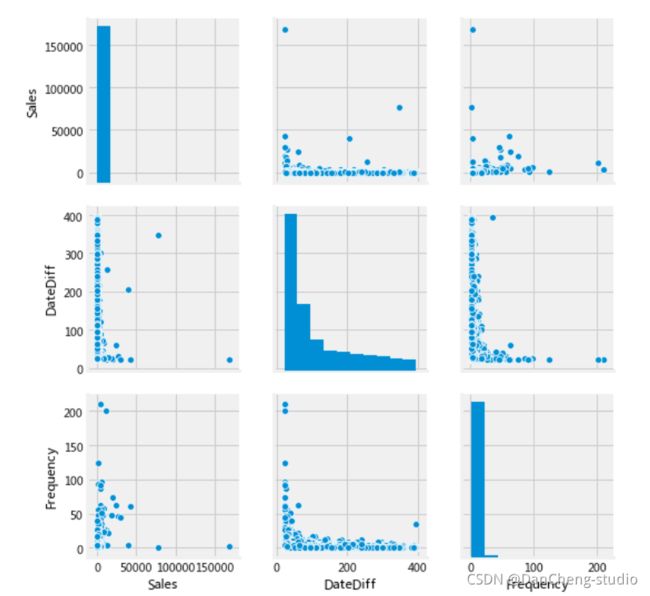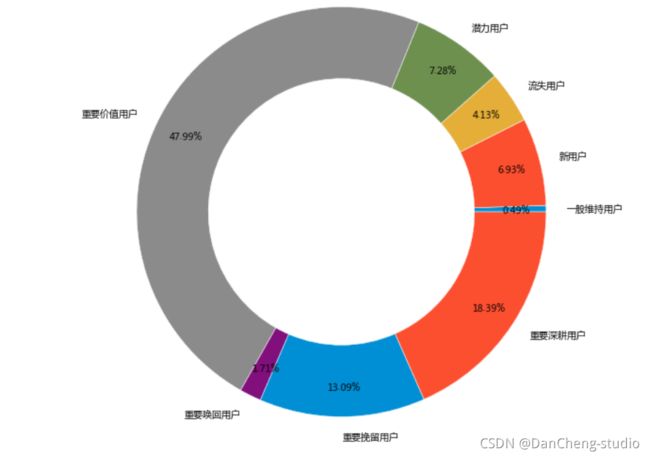【毕业设计】大数据客户价值分析(RFM模型)
文章目录
- 1 简介
- 2 数据预处理
- 3 数据分析
-
- 3.1 数据准备
- 3.2 数据可视化
-
- 3.2.1 查看数据大概分布
- 3.2.2 分布直方图
- 4 R、F、M模型
-
- 4.1 模型含义
- 4.2 R、F、M的均值
- 4.3 不同类型的客户消费份额
- 4.4 利用最近交易间隔,交易金额进行细分
- 5 最后
1 简介
Hi,大家好,这里是丹成学长的毕设系列文章!
对毕设有任何疑问都可以问学长哦!
这两年开始,各个学校对毕设的要求越来越高,难度也越来越大… 毕业设计耗费时间,耗费精力,甚至有些题目即使是专业的老师或者硕士生也需要很长时间,所以一旦发现问题,一定要提前准备,避免到后面措手不及,草草了事。
为了大家能够顺利以及最少的精力通过毕设,学长分享优质毕业设计项目,今天要分享的新项目是
大数据分析:客户价值分析 RFM模型
学长这里给一个题目综合评分(每项满分5分)
- 难度系数:4分
- 工作量:4分
- 创新点:3分
选题指导, 项目分享:
https://gitee.com/yaa-dc/BJH/blob/master/gg/cc/README.md
2 数据预处理
# 加载必要的库
import pandas as pd
import numpy as np
from pandas import DataFrame,Series
import seaborn as sns
import matplotlib.pyplot as plt
plt.style.use('fivethirtyeight')
%matplotlib inline
from warnings import filterwarnings
filterwarnings('ignore')
import os
import datetime
import plotly.offline as py
from plotly.offline import init_notebook_mode,iplot
import plotly.graph_objs as go
from plotly import tools
init_notebook_mode(connected=True)
import plotly.figure_factory as ff
from sklearn.cluster import MiniBatchKMeans, KMeans
from sklearn.metrics.pairwise import pairwise_distances_argmin
from sklearn.datasets import make_blobs
# 导入数据
path='/home/kesci/input/7947606275/data.csv'
df=pd.read_csv(path,dtype={'CustomerID':str,'InvoiceID':str})
df.head()
df=df.drop_duplicates()
# 查看描述统计
df.describe()
df.loc[df['UnitPrice']<0].UnitPrice.count()
# 查看这2行的Description是什么
df.loc[df['UnitPrice']<0,['UnitPrice','Description']]
# 删除UnitPrice小于0的和Quantity小于0的数据
df=df[(df['UnitPrice']>=0) & (df['Quantity']>0)]
3 数据分析
3.1 数据准备
# 减少重复数据
df_f = df
df_f.drop_duplicates(subset=['InvoiceNo', 'CustomerID'], keep="first", inplace=True)
#计算购买频率
frequency_df = df_f.groupby(by=['CustomerID'], as_index=False)['InvoiceNo'].count()
frequency_df.columns = ['CustomerID','Frequency']
frequency_df.set_index('CustomerID',drop=True,inplace=True)
frequency_df.head()
3.2 数据可视化
3.2.1 查看数据大概分布
3.2.2 分布直方图
plt.figure(1,figsize=(12,6))
n=0
for x in ['Frequency','DateDiff','Sales']:
n+=1
plt.subplot(1,3,n)
plt.subplots_adjust(hspace=0.5,wspace=0.5)
sns.distplot(df_rfm[x],bins=30)
plt.title('{} 直方图'.format(x))
plt.show()
4 R、F、M模型
4.1 模型含义
4.2 R、F、M的均值
计算用于划分客户的阙值,R、F、M的均值(*通过分布直方图可以发现该份数据不适合用中位数来分层,因此这里用均值做分层)
rmd = df_rfm['DateDiff'].mean()
fmd = df_rfm['Frequency'].mean()
mmd = df_rfm['Sales'].mean()
rmd,fmd,mmd
def customer_type(frame):
customer_type = []
for i in range(len(frame)):
if frame.iloc[i,1]<=rmd and frame.iloc[i,2]>=fmd and frame.iloc[i,0]>=mmd:
customer_type.append('重要价值用户')
elif frame.iloc[i,1]>rmd and frame.iloc[i,2]>=fmd and frame.iloc[i,0]>=mmd:
customer_type.append('重要唤回用户')
elif frame.iloc[i,1]<=rmd and frame.iloc[i,2]<fmd and frame.iloc[i,0]>=mmd:
customer_type.append('重要深耕用户')
elif frame.iloc[i,1]>rmd and frame.iloc[i,2]<fmd and frame.iloc[i,0]>=mmd:
customer_type.append('重要挽留用户')
elif frame.iloc[i,1]<=rmd and frame.iloc[i,2]>=fmd and frame.iloc[i,0]<mmd:
customer_type.append('潜力用户')
elif frame.iloc[i,1]>rmd and frame.iloc[i,2]>=fmd and frame.iloc[i,0]<mmd:
customer_type.append('一般维持用户')
elif frame.iloc[i,1]<=rmd and frame.iloc[i,2]<fmd and frame.iloc[i,0]<mmd:
customer_type.append('新用户')
elif frame.iloc[i,1]>rmd and frame.iloc[i,2]<fmd and frame.iloc[i,0]<mmd:
customer_type.append('流失用户')
frame['classification'] = customer_type
customer_type(df_rfm)
print('不同类型的客户总数:')
print('--------------------')
df_rfm.groupby(by='classification').size().reset_index(name='客户数')
4.3 不同类型的客户消费份额
4.4 利用最近交易间隔,交易金额进行细分
假设不规定8个分类利用模型来选择最优分类,利用最近交易间隔,交易金额进行细分
X= df_rfm[['Sales' , 'DateDiff' ,'Frequency']].iloc[: , :].values
inertia = []
for n in range(1 , 11):
algorithm = (KMeans(n_clusters = n ,init='k-means++', n_init = 10 ,max_iter=300,
tol=0.0001, random_state= 111 , algorithm='elkan') )
algorithm.fit(X)
inertia.append(algorithm.inertia_)
algorithm = (KMeans(n_clusters = 5,init='k-means++', n_init = 10 ,max_iter=300,
tol=0.0001, random_state= 111 , algorithm='elkan') )
algorithm.fit(X)
labels3 = algorithm.labels_
centroids3 = algorithm.cluster_centers_
df_rfm['label3'] = labels3
trace1 = go.Scatter3d(
x= df_rfm['Sales'],
y= df_rfm['DateDiff'],
z= df_rfm['Frequency'],
mode='markers',
marker=dict(
color = df_rfm['label3'],
size=10,
line=dict(
color= df_rfm['label3'],
# width= 10
),
opacity=0.8
)
)
data = [trace1]
layout = go.Layout(
# margin=dict(
# l=0,
# r=0,
# b=0,
# t=0
# )
height=800,
width=800,
title= 'Sales VS DateDiff VS Frequency',
scene = dict(
xaxis = dict(title = 'Sales'),
yaxis = dict(title = 'DateDiff'),
zaxis = dict(title = 'Frequency')
)
)
fig = go.Figure(data=data, layout=layout)
py.offline.iplot(fig)






